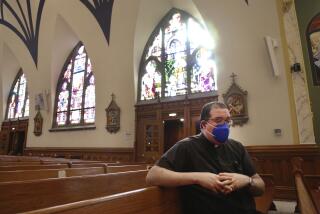A New Look at Why Catholics Donate Less
- Share via
Maybe Catholics aren’t such skinflints after all.
It’s no secret among researchers that Catholics put substantially less in collection plates than Protestants.
What has remained a mystery, however, is why the descendants of immigrants who sacrificed to build magnificent churches and schools are giving less and less, in inflation-adjusted dollars, as their incomes rise.
Now, new research indicates that Protestants and Catholics may be more alike in their giving than the numbers indicate: Both gauge their giving according to the needs of their churches, donating just enough to pay the bills.
And much of the difference in giving may be explained by the fact that it’s cheaper to run a Catholic church, according to the Champaign, Ill.-based research organization empty tomb inc.
Larger Catholic parishes offering multiple services on Sunday are more cost-efficient, and unmarried Catholic clergy are paid significantly lower salaries than most Protestant ministers.
Instead of looking only at Catholics as lagging stewards, all Christian churches need to examine whether they are teaching their members to share their wealth with the needy, as opposed to merely giving enough to keep the church lights on, the researchers conclude.
“What appears to be the situation for both Catholics and Protestants is it appears that the church in the United States has not had a positive agenda for [capitalizing on] the increasing affluence since World War II,” said Sylvia Ronsvalle, executive director of empty tomb inc.
“People are paying the bill at the church the same way they are paying any other bill in their life,” she said.
*
Several studies in recent years have shown that Catholics, despite having higher incomes than many Protestant groups, do not ante up as much in Sunday collections.
In a 1993 national survey of 625 congregations in five denominations, the average contribution per household reported by congregations ranged from $386 for Catholics to $1,696 for Assemblies of God members. Baptist households gave an average of $1,154. Presbyterians were next with $1,085, followed by Lutherans at $746.
In probing the differences, a team of researchers--Michael J. Donahue of the Minneapolis-based Search Institute, Patrick McNamara of the University of New Mexico, Charles Zech of Villanova University and Dean Hoge of Catholic University of America--found little evidence for some popular theories.
Researchers found no indication that the lower giving was tied to dissatisfaction with church policies on issues such as birth control. And the larger parish size of Catholic churches was not found to be a significant factor.
Building on those findings, empty tomb researchers began to search for other explanations.
After studying data related to the efficiencies of scale that benefit Catholic operations, they found a striking similarity in the way Catholics and Protestants approach church finances.
There are no exact figures for Catholic giving, but empty tomb used a mid-range estimate of about $5.5 billion for 1991. If Catholics were to compensate their clergy at Protestant levels, maintain the average Protestant clergy-parishioner ratio of 347 to 1, and offer only one worship service per building, it would have cost Catholics an additional $5.9 billion to $8.8 billion to maintain their churches, empty tomb estimated.
*
“When these differences are controlled, this hypothesis suggests that both the Catholic and Protestant approaches to stewardship are succeeding at the basic goal of paying the bills and maintaining the operations of the congregation,” according to the empty tomb analysis by Ronsvalle and her husband, John.
Catholic churches are cheaper to operate and pastors have told him informally that they give their members the message, “If the bills are paid, dear parishioners, you can relax now.”
“In my judgment, there are many Christians who think in terms of keeping the place open . . . and the Catholic parishioner will catch on, over time, that it doesn’t take much to run the parish,” Hoge said.
The Ronsvalles have been tracking a steady decline among Protestants in the percentage of income given to the church. In the latest edition of their annual report, “The State of Church Giving,” they note that giving has decreased in the 29 Protestant denominations they studied, from 3.14% of income in 1968 to 2.52% in 1993.
*
What both Ronsvalles and Hoge say is needed is for churches to recover the concept of giving to thank God and to share in God’s work of caring for the needy, as opposed to just giving to meet the physical needs of the church.
Church members, the Ronsvalles say, should be encouraged to reflect on the more important questions of why Christians are supposed to give in the first place.
“Both Catholic and Protestant Christians are faced with an important issue of the faith: What is stewardship beyond paying the bills and maintaining an institution?”
More to Read
Sign up for Essential California
The most important California stories and recommendations in your inbox every morning.
You may occasionally receive promotional content from the Los Angeles Times.













